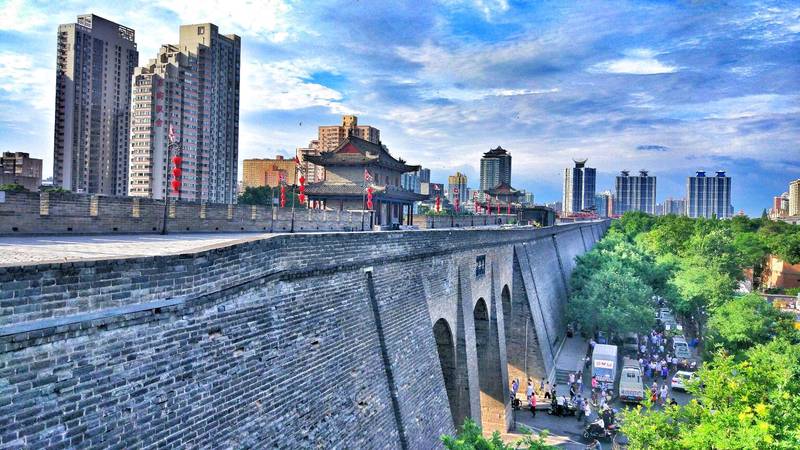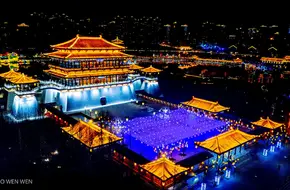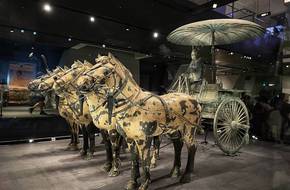Geographical Location
Xi’an, the capital of Shaanxi Province, sits in the heart of China’s Central Plain , cradled between the Qinling Mountains to the south and the Weihe River to the north . This strategic position made it a crossroads for ancient trade routes like the Silk Road. Often called the “Cradle of Chinese Civilization,” Xi’an served as the capital for 13 dynasties, including the Zhou, Qin, Han, and Tang, leaving behind a legacy of imperial palaces, tombs, and cultural treasures .
Transportation
Getting to Xi’an is easy, thanks to its Xi’an Xianyang International Airport (IATA: XIY) , which connects to major global cities. For domestic travel, the Xi’anbei Railway Station—Asia’s largest high-speed rail hub—links to cities like Beijing (4.5 hours) and Chengdu (3 hours) .
Within the city, the metro system covers key attractions like the Terracotta Warriors (Line 9) and the Muslim Quarter (Line 2). Taxis and ride-sharing apps like Didi are affordable, though traffic can be heavy. For a scenic twist, rent a bike to explore the city walls or take a horse-drawn carriage around the Bell Tower area.
Natural Landscapes
Xi’an’s rugged beauty contrasts sharply with its urban energy:
- Mount Hua: A UNESCO site and one of China’s Five Great Mountains, famous for its sheer cliffs and惊险 (thrilling) hiking trails. The cable car ride offers panoramic views of the Qinling range .
- Taibai Mountain: The highest peak in the Qinling range, with alpine meadows and hot springs. In winter, it transforms into a snowy wonderland.
- Hukou Waterfall: On the Yellow River, this “Golden Waterfall” roars through a narrow gorge, creating a misty spectacle best seen in spring or autumn .
Cultural and Historical Sites
Xi’an’s history is tangible at every turn:
- Terracotta Warriors: A UNESCO World Heritage site, this army of 8,000 life-size clay soldiers guards the tomb of Emperor Qin Shi Huang. Don’t miss the Pit 1 exhibition hall, where rows of warriors seem frozen in time .
- Xi’an City Wall: Built in the 14th century, it’s one of China’s best-preserved ancient walls. Rent a bike to cycle its 14 km perimeter and soak in views of the city.
- Big Wild Goose Pagoda: A Tang Dynasty landmark, this 64-meter pagoda once housed Buddhist scriptures brought from India by Xuanzang. The nightly fountain show at North Square is a must-see.
- Muslim Quarter: A maze of streets filled with Persian-style architecture, stalls selling Roujiamo (stewed pork in flatbread), and Liangpi (cold rice noodles). Don’t leave without trying Yangrou Paomo—a soup where you break bread into pieces yourself .
- Famen Temple: Home to a Buddha relic (a finger bone of Siddhartha Gautama), this temple complex blends ancient architecture with modern design. The Famen Temple Museum displays Tang Dynasty treasures like gold incense burners and jade artifacts .
Food and Dining
Xi’an’s cuisine is a mix of Han Chinese and Muslim flavors:
- Roujiamo: Often called “China’s hamburger,” this snack features tender, spiced pork stuffed into a crispy bread.
- Yangrou Paomo: A hearty soup made with lamb broth, hand-pulled noodles, and flatbread chunks.
- Biangbiang Noodles: Thick, chewy noodles tossed in chili oil and garlic, named for the sound they make when stretched.
- Jiaozi: Dumplings filled with pork, shrimp, or vegetables, often served in a steaming bowl of broth.
Head to Zhonglou Snack Street for street food or Defu Lane for upscale restaurants.
Modern Attractions
Xi’an seamlessly merges past and present:
- Qujiang New District: A cultural hub with the Tang Paradise (a recreated Tang Dynasty garden) and the Xi’an Art Museum.
- SKP Shopping Mall: A luxury mall with global brands and a rooftop garden.
- Xi’an Olympic Sports Center: Built for the 2021 National Games, it’s a futuristic complex with stadiums and green spaces.
Travel Tips
- Language: English signage is limited outside tourist areas. Use Google Translate or learn phrases like “Ni hao” (hello) and “Xie xie” (thank you).
- Weather: Summers are hot (up to 38°C), while winters are cold (as low as -5°C). Spring and autumn are the most pleasant.
- Safety: The city is generally safe, but keep an eye on belongings in crowded markets.
- Currency: Cash is still widely used, especially in smaller shops and street stalls.
Nearby Destinations
Extend your trip to these gems:
- Mount Hua: A 1.5-hour train ride from Xi’an, perfect for a day hike or overnight climb.
- Hukou Waterfall: A 3-hour drive or 2-hour high-speed train ride to see the Yellow River’s iconic falls.
- Chengdu: Just 3 hours by high-speed rail, home to giant pandas and spicy Sichuan cuisine.
- Luoyang: A 2-hour train ride, famous for its peony gardens and Longmen Grottoes.




